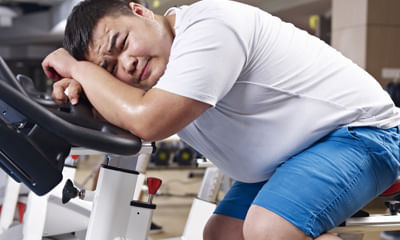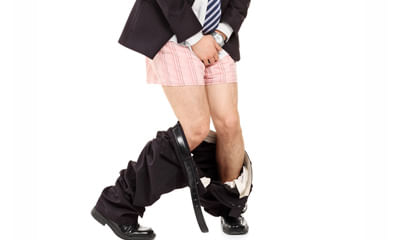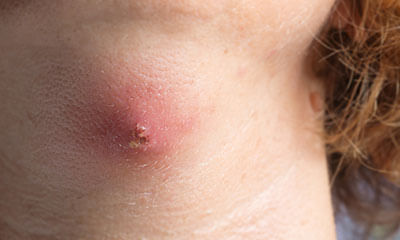How To Decrease Size Of Buttocks
I have a medium size breasts and since I was around 16 or 17 have a red splotchy looking rash under breasts. It's hot to ...
Ask Free Question
It can be jock itch/fungal infection. U can try this. U can try this wash the affected skin two to three times a day. Keep the affected area dry.Avoid excess affected skin irritation by wearing 100% cotton underwear. Avoid fabric softeners, bleaches, or harsh laundry detergents. Wash your workout clothes, underwear, socks, and towels after each use. Keep your affected area, inner thighs, and buttocks clean and dry, especially after you exercise and shower. After showering or bathing, dry the irritated affected area by gently patting it with a towel. Be sure to dry your skin thoroughly. Mix two tablespoons of apple cider vinegar in two cups of warm water. Wash the infected area with this solution and allow it to dry on its own. Another option is to apply a mixture of equal parts of white vinegar and coconut oil on the affected skin. Like hydrogen peroxide, rubbing alcohol can help kill off the fungus that's on the surface level of the skin. You can apply it directly to the affected area listerine: it has antiseptic, antifungal and antibacterial properties, which help treat skin problem here are some tips to help you manage the infection:avoid using oily skin products.Reduce your exposure to the sun. Exposure to the sun may trigger or worsen an episode, do not wear tight clothing. Wear breathable fabrics, such as cotton, to decrease sweating. For this homeopathic treatment is very effectivefor more details consult me.
A type dad diseases size like coin. Start in stomach and its expand other place of body when I touch other place they gr ...
Ask Free Question
The condition most often occurs when people wear tight-fitting clothing that traps in moisture. U can try thisâ Wash the affected skin two to three times a day. Keep the affected area dry. Avoid excess affected skin irritation by wearing 100% cotton underwear. Avoid fabric softeners, bleaches, or harsh laundry detergents. Wash your workout clothes, underwear, socks, and towels after each use. Keep your affected area, inner thighs, and buttocks clean and dry, especially after you exercise and shower. After showering or bathing, dry the irritated affected area by gently patting it with a towel. Be sure to dry your skin thoroughly. Mix two tablespoons of apple cider vinegar in two cups of warm water. Wash the infected area with this solution and allow it to dry on its own. Another option is to apply a mixture of equal parts of white vinegar and coconut oil on the affected skin. Like hydrogen peroxide, rubbing alcohol can help kill off the fungus that's on the surface level of the skin. You can apply it directly to the affected area Listerine: It has antiseptic, antifungal and antibacterial properties, which help treat skin problem Here are some tips to help you manage the infection: Avoid using oily skin products. Reduce your exposure to the sun. Exposure to the sun may trigger or worsen an episode, and a tan makes the rash more visible. Do not wear tight clothing. Wear breathable fabrics, such as cotton, to decrease sweating.
I am having skin allergy. Initially it started with a fungal infection but now it feels itchy, dry and keeps on increasi ...
Ask Free Question
The condition most often occurs when people wear tight-fitting clothing that traps in moisture. Wash the affected skin two to three times a day. Keep the affected area dry. Avoid excess affected skin irritation by wearing 100% cotton underwear. Avoid fabric softeners, bleaches, or harsh laundry detergents. Wash your workout clothes, underwear, socks, and towels after each use. Keep your affected area, inner thighs, and buttocks clean and dry, especially after you exercise and shower. After showering or bathing, dry the irritated affected area by gently patting it with a towel. Be sure to dry your skin thoroughly. Mix two tablespoons of apple cider vinegar in two cups of warm water. Wash the infected area with this solution and allow it to dry on its own. Another option is to apply a mixture of equal parts of white vinegar and coconut oil on the affected skin. Like hydrogen peroxide, rubbing alcohol can help kill off the fungus that's on the surface level of the skin. You can apply it directly to the affected area Listerine: It has antiseptic, antifungal and antibacterial properties, which help treat skin problem Here are some tips to help you manage the infection: Avoid using oily skin products. Reduce your exposure to the sun. Exposure to the sun may trigger or worsen an episode, and a tan makes the rash more visible. Do not wear tight clothing. Wear breathable fabrics, such as cotton, to decrease sweating.
I am overweight according to my age and main problem is that my thighs are very fatty and looks odd. I sometime face pro ...
Ask Free Question
You need to have diet plan based on your bmi & activities. Whatever we eat is metabolised by the body for the energy needed to do daily work and the excess is stored as fat. Abdomen is the first place to gain weight and last to disappear. In brief, weight reduction can be achieved only by reducing the intake of food 1/3 of what you take now. And by appropriate exercise plans for each part like belly, thighs, legs / chest etc. To burn off fat. Some tips 1) drink three or four cups of water whenever you feel hungry and just before eating food 2) take boiled or raw vegetable like cucumber, carrot etc. As half of your diet. Then take 1/2 of your total diet as sprouted pulses / proteinaceous food like roti, cooked pulses and remaining with rice or other carbohydrates. Oil or ghee etc. Should be just bare minimum. And do aerobic exercises, running, jogging or at least walking briskly 3-5 kms and swimming if possible, and in a gym if feasible. The most important is to burn off the energy intake by exercises. There is no short cut or medicines without exercise & dieting to take just as mush food as needed for your activities. The food we eat is utilised for our energy needs and the remaining will be stored as fat which leads to obesity. It is better to do some tests. Diet chart timingfoods to eatcalories early morninglukewarm water with lemon 1 glass0 tea without sugar + 2 biscuits90 breakfast2 rotis + 1/2 cup paneer curry330 orbrown bread upma 1 plate + milk 1 cup300 mid-morning1 banana/1/2 cup melon/20 grapes50 lunchbrown rice 1 cup (195 gm) + mixed vegetables 1/2 cup + salad 1 bowl + raita 1 small bowl345 eveningbutter milk 1 cup35 dinner2 rotis + vegetable soup 1 bowl + salad 1 bowl370 total1220/1190 cal to lose weight, you must burn more calories than you consume a day from your diet, if you burn 3000 calories, you’ll lose a pound a week. Losing fat in the legs will improve your appearance and your health. Carrying too much fat slows you down and increases your risk of heart disease and diabetes. A weight-loss goal of 1 to 2 pounds a week is reasonable, which means in 30 days you can lose 4 to 8 pounds. Losing leg fat in 30 days requires a plan of healthy eating, cardiovascular workouts and leg toning exercises. Step 1 eat a healthy, low-calorie diet. Eating more calories than your body need leads to fat gain. Cut your calories by eliminating sugary and fatty foods from your diet. Measure your portion sizes to avoid overeating. The 2010 dietary guidelines for americans suggest eating fresh, healthy foods such as fruits and vegetables, whole grains and lean proteins such as poultry. Step 2 perform 30 to 60 minutes of cardiovascular exercise five days a week during the course of 30 days. Cardiovascular exercise burns fat speeding up the weight loss process over dieting alone. Consider doing exercises that also target the legs such as rollerblading, running, hiking and bicycling. Step 3 do squats two to three days a week over the month. The american council on exercise reports that squats along with lunges are the best exercises for thighs. Start by standing with your legs a little wider than hip-width. Bend your knees, shifting your weight back as if you're going to sit down. Don't allow your knees to extend over the toes. Straighten your legs to return to the start position. Add resistance by holding dumbbells or a barbell. Step 4 perform lunges two to three days a week for 30 days. Stand with your legs hip-width apart. Step forward with your right leg, bending the knee as shift your weight forward. Keep your right knee over the ankle. Push back with the right foot to return to the start position. If you have bad knees, step backward instead of forward into the lunge. Add resistance by holding a dumbbell in each hand. Perform the lunge to the side to target the adductors and abductors -- inner and outer thighs. Step 5 take the stairs instead of the elevator or escalator during the next 30 days. Using the stairs burns fat and tones the legs. It can also cut your risk of premature death by 15 percent. Tips •continue eating healthy and exercising beyond the 30 days to maintain your weight loss and health. How to reduce fat in the buttocks a sculpted, firm backside is the goal of many who seek to improve their appearance. Strong, lean buttocks are also a sign of health. Carrying too much fat increases your risk of heart disease and diabetes. Reducing fat in the buttocks requires lifestyle changes, including a healthy diet and exercise. Step 1 reduce calorie consumption to prevent gaining more fat. To lose 1 lb. Of fat, you need to reduce or burn 3,500 calories. Cut out junk food and monitor portion sizes. Don't restrict your diet too much or you may slow your metabolism. Medline plus warns that women shouldn't eat less than 1,200 calories a day. Men shouldn't eat fewer than 1,500 calories. Step 2 burn fat with regular cardiovascular exercise. The american heart association recommends at least 30 minutes of exercise five days a week to burn fat and improve heart health. Running, hiking and stair climbing burn calories, as well as firm up the buttocks. But you can perform any exercise that you enjoy and gets your heart rate up to burn fat in the backside. Step 3 perform butt lifts. Butt lifts are ideal for beginners or people who have bad knees and can't do squats or lunges. Lay on your back with your knees bent and feet flat on the floor. Squeeze your glutes to lift your buttocks off the floor. Release to return to the start position. Perform two sets of 12 to 15 repetitions. To increase resistance, hold a dumbbell, barbell or body bar over your hips. Step 4 perform reverse extensions on a stability ball. Like butt lifts, reverse extensions target the butt muscles without putting stress on the knees. Lay face down on the ball with your hands and feet on the floor. Shift your weight so that it's supported by your hands. Squeeze your glutes to lift your legs until they are parallel to the floor. Hold your legs together through the range of motion. Lower to the start position repeating two sets of 12 to 15 reps. Step 5 do squats. The american council on exercise reports that squats, along with lunges are the best exercise for firming up the buttocks. Stand with your feet slightly wider than your hips. Bend at the knees, pushing your hips back as if you're going to sit down. Your head and chest are lifted and your knees stay behind your toes. Return to the start position and repeat two sets of 12 to 15 reps. Add more resistance by holding dumbbells, a barbell or body bar, or using resistance bands. Step 6 take the stairs. Instead of using the elevator or escalator -- always use the stairs to burn fat and tighten the glutes. Things you'll need •dumbbells, barbell or body bar •resistance band •stability ball reducing arms size go for skipping if you think it's irrelevant, then you are wrong. Skipping is the best cardio workout and it's inexpensive as well. It doesn't just help you sweat out the fat from your body, but gives you sleek and tone arms too. "skipping rope affects arms muscles as you lift your body's weight as well as move your arms in circular motion. This increases the activity in the arms. Count seconds instead of skipping repetitions to make the process more effective, says a fitness experts. Keep stretching don't wait for the evening or morning fitness regime and stretch your arms as and when you get time. This will not only keep you active, but also release the tension, "stretching tones the arm muscles and brings them back in shape. Do it in the office, post meeting or after finishing a report. He suggests these exercises that you can do in your office. - interlock your fingers behind your head and stretch your arms up. Make sure the elbows are behind your head. Now, bend your waist right for a few seconds and repeat the same on the left. Keep arms stretched and straight. - hold both your palms together behind the lower spine and interlock the fingers. Stretch both your arms backward so that chest comes forward. This is also beneficial to relieve the back stress. Rotate wrist wrist rotation affects your shoulders and lower arms which are the plumpest areas. "hold one to two pounds of dumbbells in each hand and stand up. The gap between your feet should be equal to your shoulder length. Extend both the hands forward and keep them firm. Now, swiftly rotate your wrist upward and inward as far as possible. This will help tone the arm muscles,”. Lift your body up do you remember how you used to do pull-ups in the park as a kid? You have to just follow the same. Hold a sturdy strong rod that can bear your body weight. Grasp it firmly and pull yourself up the floor. When you go up to hold the position for a few seconds and let your arm muscles take all the strain. Do a set of 20 and after a two-minute break, repeat the set. In case, you are doing it for the first time, then, do as many pull-ups as you can, but don't strain yourself. Triceps with one arm sit on the floor and place your hands almost a foot behind your hips; your fingers should point towards the butt. Your legs and feet should be pressed together, knees bent and feet flat on the floor. Keep your arm straight to raise your hips above the floor. Bend your left elbow only with one arm and lower your butt as close to the floor as possible without actually touching it. Repeat it with the right elbow.
Hi, During kegel. While contracting muscle. It feels that penis is contracted inside. Is it fine? ...
Ask Free Question
Kegel or pelvic muscle exercises are discrete exercises that strengthen the perineal or pubococcygeus muscles. In the past, they have been largely promoted by physicians to their female patients in an effort to aid with stressincontinence following childbirth. However, these same exercises are now being promoted to men in an effort to improve urinary incontinence, fecal incontinence, and even sexual health. Unlike typical exercise routines, these exercises don't require the participant to buy any weights or expensive machines. What are the benefits of Kegel exercises for men? Kegel exercises primarily aid men with urinary incontinence. Besides preventing embarrassing urine leakage, they also decrease the urge to void. Secondly, they have been shown to help male sexual health by allowing some men's erections to last longer when affected by sexual dysfunction and premature ejaculation. These benefits all equate to a better quality of life. These exercises are often recommended to patients with weakened pelvic floor muscles such as patients with diabetes, patients having had a prostate surgery in the past such as a radical prostatectomy, or obese patients. It should also be mentioned that these exercises have not been scientifically proven to increase penis size and are thus not recommended solely for this purpose. Kegel exercises are harmless if performed correctly. Chest and abdominal pain have been reported in some, but these occurrences are the result of inappropriately performed exercises. • How to do kegel ex’s • • Find the right muscles. To identify your pelvic floor muscles, stop urination in midstream or tighten the muscles that keep you from passing gas. These maneuvers use your pelvic floor muscles. Once you've identified your pelvic floor muscles, you can do the exercises in any position, although you might find it easiest to do them lying down at first. • Perfect your technique. Tighten your pelvic floor muscles, hold the contraction for three seconds, and then relax for three seconds. Try it a few times in a row. When your muscles get stronger, try doing Kegel exercises while sitting, standing or walking. • Maintain your focus. For best results, focus on tightening only your pelvic floor muscles. Be careful not to flex the muscles in your abdomen, thighs or buttocks. Avoid holding your breath. Instead, breathe freely during the exercises. • Repeat 3 times a day. Aim for at least three sets of 10 repetitions a day. Don't make a habit of using Kegel exercises to start and stop your urine stream. Some doctors think this could cause a bladder infection. Now that you have located your pelvic floor muscles, you can exercise them even when you do not have to urinate (pee) by following these simple steps: 1. Tighten and hold your pelvic floor muscles for five seconds (count 1 one thousand, 2 one thousand, 3 one thousand, 4 one thousand, 5 one thousand). 2. Relax your pelvic muscles. You have just done one Kegel exercise. You should plan to do 10 to 20 Kegel exercises three to four times each day. Another way to tighten your pelvic floor muscles is to: 1. Squeeze the muscles in your anus (like you are holding a bowel movement). 2. Relax your pelvic floor muscles after each attempt. 3. Repeat this exercise 10 to 20 times. When you do your Kegel exercises, remember • Do not hold your breath. • Do not push down. Squeeze your muscles together tightly and imagine that you are trying to lift this muscle up. • Do not tighten the muscles in your stomach, buttocks, or thighs. • Relax your pelvic floor muscles between each squeeze.
How to find pelvic muscles to perform kegel exercise? Is there any side effect of doing kegel? ...
Ask Free Question
Kegel exercises primarily aid men with urinary incontinence. Besides preventing embarrassing urine leakage, they also decrease the urge to void. Secondly, they have been shown to help male sexual health by allowing some men's erections to last longer when affected by sexual dysfunction and premature ejaculation. These benefits all equate to a better quality of life. These exercises are often recommended to patients with weakened pelvic floor muscles such as patients with diabetes, patients having had a prostate surgery in the past such as a radical prostatectomy, or obese patients. It should also be mentioned that these exercises have not been scientifically proven to increase penis size and are thus not recommended solely for this purpose. Kegel exercises are harmless if performed correctly. Chest and abdominal pain have been reported in some, but these occurrences are the result of inappropriately performed exercises. •How to do kegel ex’s •Find the right muscles. To identify your pelvic floor muscles, stop urination in midstream or tighten the muscles that keep you from passing gas. These maneuvers use your pelvic floor muscles. Once you've identified your pelvic floor muscles, you can do the exercises in any position, although you might find it easiest to do them lying down at first. •Perfect your technique. Tighten your pelvic floor muscles, hold the contraction for three seconds, and then relax for three seconds. Try it a few times in a row. When your muscles get stronger, try doing Kegel exercises while sitting, standing or walking. •Maintain your focus. For best results, focus on tightening only your pelvic floor muscles. Be careful not to flex the muscles in your abdomen, thighs or buttocks. Avoid holding your breath. Instead, breathe freely during the exercises. •Repeat 3 times a day. Aim for at least three sets of 10 repetitions a day. Don't make a habit of using Kegel exercises to start and stop your urine stream. Some doctors think this could cause a bladder infection. Now that you have located your pelvic floor muscles, you can exercise them even when you do not have to urinate (pee) by following these simple steps: 1.Tighten and hold your pelvic floor muscles for five seconds (count 1 one thousand, 2 one thousand, 3 one thousand, 4 one thousand, 5 one thousand). 2.Relax your pelvic muscles. You have just done one Kegel exercise. You should plan to do 10 to 20 Kegel exercises three to four times each day. Another way to tighten your pelvic floor muscles is to: 1.Squeeze the muscles in your anus (like you are holding a bowel movement). 2.Relax your pelvic floor muscles after each attempt. 3.Repeat this exercise 10 to 20 times. When you do your Kegel exercises, remember•Do not hold your breath. •Do not push down. Squeeze your muscles together tightly and imagine that you are trying to lift this muscle up. •Do not tighten the muscles in your stomach, buttocks, or thighs. •Relax your pelvic floor muscles between each squeeze.
How to do kegel exercise properly and correctly? Please tell me in easy and understandable way. ...
Ask Free Question
Kegel exercises primarily aid men with urinary incontinence. Besides preventing embarrassing urine leakage, they also decrease the urge to void. Secondly, they have been shown to help male sexual health by allowing some men's erections to last longer when affected by sexual dysfunction and premature ejaculation. These benefits all equate to a better quality of life. These exercises are often recommended to patients with weakened pelvic floor muscles such as patients with diabetes, patients having had a prostate surgery in the past such as a radical prostatectomy, or obese patients. It should also be mentioned that these exercises have not been scientifically proven to increase penis size and are thus not recommended solely for this purpose. Kegel exercises are harmless if performed correctly. Chest and abdominal pain have been reported in some, but these occurrences are the result of inappropriately performed exercises. •How to do kegel ex’s ••Find the right muscles. To identify your pelvic floor muscles, stop urination in midstream or tighten the muscles that keep you from passing gas. These maneuvers use your pelvic floor muscles. Once you've identified your pelvic floor muscles, you can do the exercises in any position, although you might find it easiest to do them lying down at first. •Perfect your technique. Tighten your pelvic floor muscles, hold the contraction for three seconds, and then relax for three seconds. Try it a few times in a row. When your muscles get stronger, try doing Kegel exercises while sitting, standing or walking. •Maintain your focus. For best results, focus on tightening only your pelvic floor muscles. Be careful not to flex the muscles in your abdomen, thighs or buttocks. Avoid holding your breath. Instead, breathe freely during the exercises. •Repeat 3 times a day. Aim for at least three sets of 10 repetitions a day. Don't make a habit of using Kegel exercises to start and stop your urine stream. Some doctors think this could cause a bladder infection. Now that you have located your pelvic floor muscles, you can exercise them even when you do not have to urinate (pee) by following these simple steps: 1.Tighten and hold your pelvic floor muscles for five seconds (count 1 one thousand, 2 one thousand, 3 one thousand, 4 one thousand, 5 one thousand). 2.Relax your pelvic muscles. You have just done one Kegel exercise. You should plan to do 10 to 20 Kegel exercises three to four times each day. Another way to tighten your pelvic floor muscles is to: 1.Squeeze the muscles in your anus (like you are holding a bowel movement). 2.Relax your pelvic floor muscles after each attempt. 3.Repeat this exercise 10 to 20 times. When you do your Kegel exercises, remember•Do not hold your breath. •Do not push down. Squeeze your muscles together tightly and imagine that you are trying to lift this muscle up. •Do not tighten the muscles in your stomach, buttocks, or thighs. •Relax your pelvic floor muscles between each squeeze.
I get large red swollen boils at my buttock kindly suggest what should I do. Its recurring since 5 years n it burst out ...
Ask Free Question
Boils and abscesses are red, pus-filled bumps that form under the skin. They’re often painful, and they grow larger until they are drained. Boils are caused by bacteria that infect and then inflame hair follicles. They can grow to the size of a baseball, and the area surrounding the skin can be red and painful, too. You shouldn’t pick at or squeeze a boil. If it isn’t drained properly, it could infect nearby areas or push the infection deeper into the skin and cause more boils. The primary home remedy for most boils is heat application, usually with hot or warm water soaks or warm compresses. It may be necessary to apply them 20 minutes at a time for three to four times daily. Heat application increases the circulation to the area and allows the body to better fight off the infection by bringing antibodies and white blood cells to the site of infection. Homeopathic treatment has very encouraging results and gives relief in long term.
Kindly tell me proper way to do kegel exercise in chronic proctalgia, tell different types of kegels and their benefits. ...
Ask Free Question
Kegel or pelvic muscle exercises are discrete exercises that strengthen the perineal or pubococcygeus muscles. In the past, they have been largely promoted by physicians to their female patients in an effort to aid with stressincontinence following childbirth. However, these same exercises are now being promoted to men in an effort to improve urinary incontinence, fecal incontinence, and even sexual health. Unlike typical exercise routines, these exercises don't require the participant to buy any weights or expensive machines. What are the benefits of Kegel exercises for men? Kegel exercises primarily aid men with urinary incontinence. Besides preventing embarrassing urine leakage, they also decrease the urge to void. Secondly, they have been shown to help male sexual health by allowing some men's erections to last longer when affected by sexual dysfunction and premature ejaculation. These benefits all equate to a better quality of life. These exercises are often recommended to patients with weakened pelvic floor muscles such as patients with diabetes, patients having had a prostate surgery in the past such as a radical prostatectomy, or obese patients. It should also be mentioned that these exercises have not been scientifically proven to increase penis size and are thus not recommended solely for this purpose. Kegel exercises are harmless if performed correctly. Chest and abdominal pain have been reported in some, but these occurrences are the result of inappropriately performed exercises. •How to do kegel ex’s ••Find the right muscles. To identify your pelvic floor muscles, stop urination in midstream or tighten the muscles that keep you from passing gas. These maneuvers use your pelvic floor muscles. Once you've identified your pelvic floor muscles, you can do the exercises in any position, although you might find it easiest to do them lying down at first. •Perfect your technique. Tighten your pelvic floor muscles, hold the contraction for three seconds, and then relax for three seconds. Try it a few times in a row. When your muscles get stronger, try doing Kegel exercises while sitting, standing or walking. •Maintain your focus. For best results, focus on tightening only your pelvic floor muscles. Be careful not to flex the muscles in your abdomen, thighs or buttocks. Avoid holding your breath. Instead, breathe freely during the exercises. •Repeat 3 times a day. Aim for at least three sets of 10 repetitions a day. Don't make a habit of using Kegel exercises to start and stop your urine stream. Some doctors think this could cause a bladder infection.
In kegel exercise if not able to find PV muscle then can we continue exercise with stopping pee in Midway? ...
Ask Free Question
What are the benefits of Kegel exercises for men? Kegel exercises primarily aid men with urinary incontinence. Besides preventing embarrassing urine leakage, they also decrease the urge to void. Secondly, they have been shown to help male sexual health by allowing some men's erections to last longer when affected by sexual dysfunction and premature ejaculation. These benefits all equate to a better quality of life. These exercises are often recommended to patients with weakened pelvic floor muscles such as patients with diabetes, patients having had a prostate surgery in the past such as a radical prostatectomy, or obese patients. It should also be mentioned that these exercises have not been scientifically proven to increase penis size and are thus not recommended solely for this purpose. Kegel exercises are harmless if performed correctly. Chest and abdominal pain have been reported in some, but these occurrences are the result of inappropriately performed exercises. •How to do kegel ex’s ••Find the right muscles. To identify your pelvic floor muscles, stop urination in midstream or tighten the muscles that keep you from passing gas. These maneuvers use your pelvic floor muscles. Once you've identified your pelvic floor muscles, you can do the exercises in any position, although you might find it easiest to do them lying down at first. •Perfect your technique. Tighten your pelvic floor muscles, hold the contraction for three seconds, and then relax for three seconds. Try it a few times in a row. When your muscles get stronger, try doing Kegel exercises while sitting, standing or walking. •Maintain your focus. For best results, focus on tightening only your pelvic floor muscles. Be careful not to flex the muscles in your abdomen, thighs or buttocks. Avoid holding your breath. Instead, breathe freely during the exercises. •Repeat 3 times a day. Aim for at least three sets of 10 repetitions a day. Don't make a habit of using Kegel exercises to start and stop your urine stream. Some doctors think this could cause a bladder infection. Now that you have located your pelvic floor muscles, you can exercise them even when you do not have to urinate (pee) by following these simple steps: 1.Tighten and hold your pelvic floor muscles for five seconds (count 1 one thousand, 2 one thousand, 3 one thousand, 4 one thousand, 5 one thousand). 2.Relax your pelvic muscles. You have just done one Kegel exercise. You should plan to do 10 to 20 Kegel exercises three to four times each day. Another way to tighten your pelvic floor muscles is to: 1.Squeeze the muscles in your anus (like you are holding a bowel movement). 2.Relax your pelvic floor muscles after each attempt. 3.Repeat this exercise 10 to 20 times. When you do your Kegel exercises, remember•Do not hold your breath. •Do not push down. Squeeze your muscles together tightly and imagine that you are trying to lift this muscle up. •Do not tighten the muscles in your stomach, buttocks, or thighs. •Relax your pelvic floor muscles between each squeeze.









